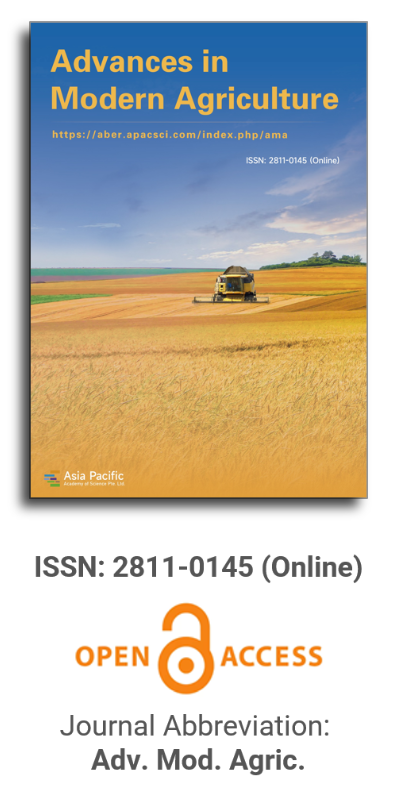


Welcome to Volume 5, Issue 3 of Advances in Modern Agriculture. This issue offers the most recent research findings in modern agriculture from novel research viewpoints, revealing the current concerns in modern agriculture. This issue includes an analysis of agricultural sector indicators, the performance of modern farming machines, the environmental conditions for high crop yields, and biomaterials' application in agriculture. These papers underline the close connection between agriculture and sustainability, investigate the best approaches to improve agricultural production, and provide impetus for the advancement of modern agricultural research.
In the new policy established by the Cuban state for the agricultural sector, the achievement of food sovereignty and sustainability of said sector is established as a basic principle, which was endorsed in the current Law of Food Sovereignty and Food and Nutritional Security. For this reason, each municipality in the country, and under certain levels of autonomy, must guarantee compliance with the aforementioned law. For this, strict control of the structures of the territorial agricultural system and the behavior of its structures is necessary. With the completion of this work, the characterization, diagnosis and evaluation of some sustainability indicators for the agricultural sector in the Trinidad Municipality were established as objectives, in the period between 2015 and 2020, for this a work team was created that was able to collect, organize, analyze, compare and evaluate the information that appeared in the National Office of Statistics and Information of the Republic of Cuba, between the years 2015 and 2020, finding as one of the results that the workforce indicator used in this sector has suffered a drastic decrease, not guaranteeing the man-area relationship necessary to achieve food sovereignty and the sustainability of the sector at a territorial level.
In Cambodia, vegetable crops are planted by hand, making it hard to meet local market demands. However, this production can be boosted by using a mechanical transplanter with two-wheel tractors to cut input costs, when introduced to farmers, while production and productivity can be accelerated. Thus, this research aimed to (1) evaluate the working performance of a locally made vegetable transplanter against manual planting and (2) compare plant survival rates. The study included fabrication, testing, modification, and experiments with farmers, starting from January 2023 to July 2024. The transplanter was fabricated, tested, and improved by the Royal University of Agriculture. Then, two experiments were carried out with a vegetable farming community in Tram Kak District, Takeo Province, Cambodia. Tomato was selected for the testing, choosing seedlings aged four weeks. The randomized complete block design (RCBD) was applied for both experiments with two treatments, manual planting and transplanter use, replicated four times. The results show that the working performance of the transplanter was six times faster than manual planting. Its speed, total field capacity, and planting rate were 1.03 km/h, 0.052 ha/h, and 27 plants/min, respectively, but missed planting was about 4%. Within-row spacing was similar (0.58 m), while using the transplanter made the plants incline at a steeper angle (63°), but could save 81.9% of time, when compared to manual planting. Both treatments had 100% plant survival rates evaluated one week after the transplanting. In short, using the transplanter can save both time and labor, but further assessment should be made with more kinds of fruit vegetable based on different seedling ages, so that the specifications can be confirmed, which is good for actual adoption for farmers.
Wheat is a rabi season crop and is highly susceptible to abrupt increases/decreases in weather parameters. So, a study was conducted to compute the critical limits of temperature, relative humidity, and rainfall by analyzing meteorological and crop data (1999–00 to 2018–19) for six locations (Ballowal Saunkhari, Ludhiana, Patiala, Amritsar, Bathinda, and Faridkot) in Punjab. Amongst the 20 years, high, medium, and low yield years for each location were identified, and then meteorological data for crop growth stages, i.e., sowing-emergence (43–47 Standard Meteorological Week (SMW)), vegetative (48–02 SMW), anthesis (03–06 SMW), grain filling (07–11 SMW), and physiological maturity (12–15 SMW), were tabulated. The week-wise deviations of maximum/minimum temperature, maximum/minimum relative humidity, and rainfall from normal data of those 20 years under study were computed to derive their critical limits. Then these stage-wise critical limits were validated using the actual yields achieved during crop years 2019–20, 2020–21, and 2021–22. During a good crop year 2019–20, the upper and lower limits of the ranges accounted for high yields obtained at 03 locations and medium yields at the remaining 03 locations. During the crop year 2020–21, when the medium yield was obtained at all six locations, the major reason was the deviation of temperature above the upper range during the later grain-filling stage. On the other hand, during 2021–22, when low yield was reported at 03 locations and medium yield at remaining 03 locations, in addition to temperature deviations, heavy rainfall during SMW 1 and 2 (late vegetative stage) and hot and dry weather during SMW 10 and 11 (late grain development stage) were the major reasons. Hence it may be concluded that to get higher wheat productivity during vegetative growth, flowering, and grain filling, the maximum/minimum temperature ranges should be 16–22/4–9 ℃, 21–28/7–13 ℃ and 25–32/11–16 ℃, respectively; the maximum/minimum relative humidity ranges should be 85%–99%/39%–77%, 80%–92%/32%–66% and 75%–86%/31%–59%, respectively.
Over the past few decades, advancements in agricultural science and technology have driven significant changes in China’s agriculture. This study uses the Wuqiao Experimental Station, established in 1983 in the North China Plain, as a case study to explore the trajectory of regional agricultural research in China over the past 40 years. By analyzing the keywords of all articles produced at this station, the study reveals shifts in research focus, methods, and agricultural practices over time. The analysis shows that the focus of agricultural research has shifted from yield-centered agricultural production and management (APM) to sustainability-oriented agroecology and environment (AE). Additionally, crop research has deepened, evolving from basic crop management to more detailed studies of plant anatomy, physiology, and advanced methods, including high-throughput sequencing and big data analysis. Despite these advances, concerns have emerged regarding the narrowing of research scope to a limited number of crops, primarily wheat and maize, which may reduce agricultural resilience. Furthermore, while research output has increased, a disconnect persists between scientific research and real-world agricultural challenges, such as heat stress and crop quality. This gap underscores the importance of ensuring that agricultural research remains relevant and addresses pressing issues related to food security and environmental sustainability. This study highlights the need to expand crop diversity, integrate sustainable practices, and adopt cutting-edge research methods to ensure the future resilience of China’s agricultural systems. The findings provide valuable insights into trends and future directions in agricultural research in China, emphasizing the importance of a balanced approach to addressing current and future challenges.
A concise review of the main current natural sources used to produce chitin—the starting material to produce chitooligosaccharides (COS)—is presented, including algae, arthropods, birds, fish, fungi, mollusks, and, possibly, plants. The principal approaches addressed to produce COSs, grouped as physical, chemical, and biological processes, are also outlined. Subsequently, the COS more relevant applications related to agriculture are briefly outlined, i.e., induction of innate immunity in plants, growth biostimulation, soil amending, biocidal activity, etc. Some interesting findings of this review are: (a) A clear relationship has been undoubtedly established between the low molecular weights (MWs) of these chitinous materials and their striking bioactivities. (b) There is no universal consensus about the limit MW below which a substance can be considered a COS, and some of the proposed limit values are supported in works that have not proposed them. (c) The preparation and application of COS is an active field of research due to the accessibility of chitin sources anywhere and the variety of preparation methods available, as well as the multiple possibilities of modification that these materials offer for the preparation of bioactive derivatives. (d) The chemical modification of the great number of existing COS by a wide range of agents and approaches, including computer simulation studies, is a virgin field that could generate products with powerful elicitor properties. (e) Biocidal activities of COSs, advantaged with their greater water solubilities than chitin and chitosan, are remarkably attractive due to the possibility of replacing, partial or completely, injurious synthetic products currently in use. Similarly, this review makes it possible to appreciate that the preparation and separation of COS with well-defined structures could boost the discovery of the specific regulatory mechanisms that each oligomer species can activate (or repress), that is, defense mechanisms in plants.

Prof. Zhengjun Qiu
Zhejiang University, China

Cheng Sun
Academician of World Academy of Productivity Science; Executive Chairman, World Confederation of Productivity Science China Chapter, China
Indexing & Archiving
In the realm of modern agriculture, the integration of cutting-edge technologies is revolutionizing the way we approach sustainable farming practices. A recent study published in Advances in Modern Agriculture titled "Classification of cotton water stress using convolutional neural networks and UAV-based RGB imagery" has garnered significant attention for its innovative approach to precision irrigation management. Conducted by researchers from Institute of Data Science and the AgriLife Research and Extension Center of Texas A&M University (authors's information is below). This study introduces a novel method for classifying cotton water stress using unmanned aerial vehicles (UAVs) and convolutional neural networks (CNNs), offering a powerful solution for optimizing water use in agriculture.
Modern agricultural technology is evolving rapidly, with scientists collaborating with leading agricultural enterprises to develop intelligent management practices. These practices utilize advanced systems that provide tailored fertilization and treatment options for large-scale land management.
This journal values human initiative and intelligence, and the employment of AI technologies to write papers that replace the human mind is expressly prohibited. When there is a suspicious submission that uses AI tools to quickly piece together and generate research results, the editorial board of the journal will reject the article, and all journals under the publisher's umbrella will prohibit all authors from submitting their articles.
Readers and authors are asked to exercise caution and strictly adhere to the journal's policy regarding the usage of Artificial Intelligence Generated Content (AIGC) tools.
Asia Pacific Academy of Science Pte. Ltd. (APACSCI) specializes in international journal publishing. APACSCI adopts the open access publishing model and provides an important communication bridge for academic groups whose interest fields include engineering, technology, medicine, computer, mathematics, agriculture and forestry, and environment.


 Open Access
Open Access

.jpg)
.jpg)

.jpg)
